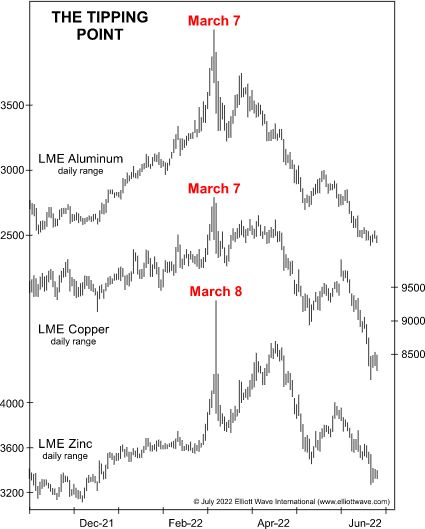Aluminum, Copper, Zinc: The 3 Horsemen of the Upcoming "Econocalypse" / Commodities / Metals & Mining
This suggests "a burgeoning slowdown in economic activity"
It may seem strange to bring up deflation when surveys show that inflation is the public's number one worry.
But who would have thought that inflation would become a big issue, say, just two years ago?
Right -- a relatively small percentage of people. The point is: Things can unexpectedly change -- fast.
Consider the price of commodities: The Goldman Sachs Spot Commodity Index hit a high on March 8, and so did the Bloomberg Commodity Index. Crude oil futures made an intraday high on March 7 and a closing high on March 8. Platinum reached a closing high on March 7.
The July Global Market Perspective, a monthly Elliott Wave International publication which covers 50-plus worldwide financial markets, mentioned other commodities which also made highs during the same time as it showed this chart and said:

Aluminum, copper and zinc topped [on March 7], as did nickel and lead. The significant price declines since March 7-8 suggest a burgeoning slowdown in world economic activity and may mark a tipping point from inflationary pressures to deflationary ones.
So, you see why deflation is not such a far-fetched notion after all.
Indeed, at least a couple of other factors point to "a burgeoning slowdown in world economic activity."
The first is widespread layoffs. Just a few months ago, technology companies were on a major hiring spree, which is in stark contrast from what's going on now (Marketwatch, June 21):
From Great Resignation to Forced Resignation: Tech companies are shifting to layoffs after a huge ramp up in hiring
Layoffs have also been notable in cryptocurrency and real estate companies.
Another indication of a global economic slowdown can be summed up in this headline from FreightWaves, a supply chain industry information company (June 7):
US Import Demand is Dropping Off a Cliff
U.S. containerized imports from all countries declined 36% year-over-year.
Getting back to commodities, the Elliott wave model can help you determine "what's next" with a high degree of confidence.
While no analytical method can see into the future, Elliott waves do reflect the repetitive patterns of investor psychology. Here's what Frost & Prechter said in their Wall Street classic, Elliott Wave Principle: Key to Market Behavior:
The Wave Principle is governed by man's social nature, and since he has such a nature, its expression generates forms. As the forms are repetitive, they have predictive value.
You can access the entire online version of the book for free once you become a member of Club EWI -- the world's largest Elliott wave educational community (about 500,000 worldwide members and growing).
A Club EWI membership is also free and opens the door to complimentary access to a wealth of Elliott wave resources on financial markets, investing and trading.
Click the link to get started right away: Elliott Wave Principle: Key to Market Behavior -- get instant and free access.
This article was syndicated by Elliott Wave International and was originally published under the headline Aluminum, Copper, Zinc: The 3 Horsemen of the Upcoming "Econocalypse". EWI is the world's largest market forecasting firm. Its staff of full-time analysts led by Chartered Market Technician Robert Prechter provides 24-hour-a-day market analysis to institutional and private investors around the world.
© 2005-2019 http://www.MarketOracle.co.uk - The Market Oracle is a FREE Daily Financial Markets Analysis & Forecasting online publication.
